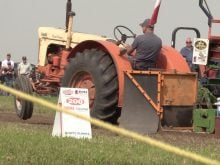Higher grain prices are putting the shine back on agriculture, according to the young farmers in a panel discussion at the recent Ag Days in Brandon last week, but lifestyle is still the biggest magnet drawing them back to the farm.
“I’m positive about the short term, and a little less positive about the long term,” said Leigh Smith, who operates a third-generation, 3,000 acre grain and beef farm with his wife and parents near Oak Lake, Man.
Smith, who is president of the local agricultural society and a hockey coach, said part of the attraction of farming is that it offers opportunities for community involvement in a small town environment.
Read Also

Try these great ways to use summer squash in season
Summer squash is harvested before it fully matures, which means its skin is still tender and full of flavour. Here are some great summer squash recipes for you to try.
“There are so many benefits to living in small towns. I think the main reason why people left back in the ’40s and the present time is because they didn’t feel like they had the amenities they thought they could get from city life,” he said.
“I think people are getting more detached from where they are in the city. They are becoming ‘hermitized.’ I think they are looking for things that rural life offers.”
On the downside, acquiring capital assets is a huge obstacle for new farmers, he said.
“A young farmer would have a very tough time today. The banks would not look at them, even if they had the best business plan.”
One good way to get into farming, he said, would be to buy a few acres, start off small and produce high quality, direct-marketed produce for farmers’ markets.
Generational transfers are a big issue for young farmers, who will be in charge of risky, million-dollar operations. That takes years of preparation for both generations, he said, as well as good, two-way communication in an emotionally charged process.
“We’re dealing with big money these days. There are a lot of challenges. You’re dealing with your parent’s retirement fund.”
Mike Gillis, who farms and does custom work near Morden with his brother and also operates a farm supply store, said that few people, especially city folk, realize the struggles farmers go through every day as they try to make a living.
“We have enormous input costs and machinery costs, like any business out there. But we are always at the mercy of the weather, and at the end of the day, market prices,” said Gillis, 28, who started farming at age 18.
“Let’s think crazy for a minute. Imagine if it was mandatory for everyone unrelated to agriculture to spend at least one day at a show like Ag Days, to walk around and find out the prices of machinery and inputs and to see first hand the technology and science that goes into farming. I’m sure it would be an eye opener.”
He said the three top challenges faced by young farmers are generational transitions, financing and uncertain weather.
“Do you say, ‘Hey Dad, how about you hand over all the land and machinery and write me a cheque for $500,000 to put the crop in. Actually, leave that cheque blank because I’m not sure about what the price of fertilizer will be by spring.’ “
Rising land prices are squeezing everyone, young and old, he said.
“You’re 20 or 30 years old and you sit down with the banker and try to explain to the guy that you need a line of credit for three or four times the value of his house. And the guy is twice your age. It’s not impossible, but it’s hard.”
The weather is the only thing farmers can’t do anything about. Finding the right seeding window in spring seems to be getting harder because of the varying extremes of moisture levels in recent years, said Gillis.
The future looks more rewarding with its higher grain prices, but cash rents, at $50 to $85 per acre in his area, are putting pressure on young farmers.
Still, opportunities in the form of new technology, such as steering systems, new crop varieties, variable rate application and yield monitors offer farmers new ways of increasing profitability.
“The opportunities are really endless, if you look at them that way,” said Gillis. “We just have to use them to try and better our operations.”
Eric McLean, a university graduate with a background in the feed business, farms 6,000 acres and has a pedigreed seed business near Oak River with his wife and her family.
“I like the physical benchmarks every day. I like to know that if I work hard I’ll shovel that bin dry or get the chores done,” he said.
“It’s a wonderful environment to raise your kids in, letting them go out and play and eat the dirt. It’s a great thing.
“There’s a great mental and moral wellness that comes from farming. You’re making a difference. You’re feeding the world, at one with nature and making a good, honest living.”
McLean noted that while starting out large scale is nearly impossible for young farmers, the failure rate of small, entrepreneurial farms is also high.
“There’s more risk with less reward, and it seems input prices are going up faster than commodity prices. The game stakes have become way too high to work off farm and try to farm at night or on the weekends. Absence leads to lost revenue.”
The two directions for farming, said McLean, are the new management-type system versus the old apprenticeship model.
“If you go back to farm with your dad, you study underneath the master until you’ve learned absolutely everything. But at the end of the day, it’s a very stressful environment,” he said.
“We’re asking the apprentice to be responsible for every factor of farming right now. A management system, on the other hand, takes responsibility and fractionates it out. It puts it on the shoulders of others, whether it’s hired or skilled labour or agronomy advice.
“We need to find a way to let the masters exit gracefully and intact.”
In the future, smaller farms, many of which start out as hobby acreages, could see a revival, he added.
“Those guys start daydreaming, and one day they think, ‘maybe I’ll sow some pumpkins, or put in a berry patch, or put up a horse stable.’ Before they know it, they’ve got a riding arena, they’re charging it out and they’re making money on it. Or they’ve got a pumpkin patch that’s making more gross revenue per acre than any grain operation,” McLean said.
“The biggest thing is, the small farms are ingenious, intensive, adaptive and creative. There’s no apprenticeship structure, nobody telling them, ‘That’s not the way things are done.’ “














